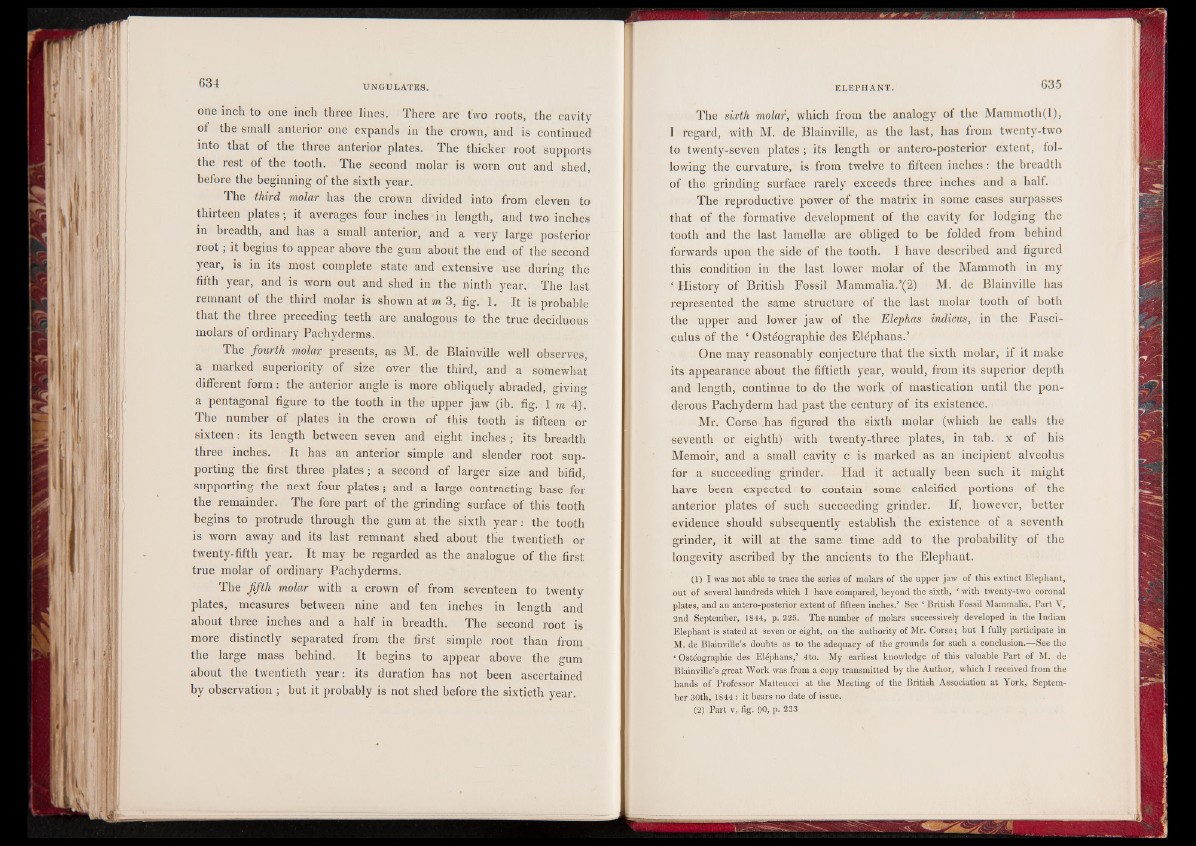
one inch to one inch three lines. There are two roots, the cavity
of the small anterior one expands in the crown, and is continued
into that of the three anterior plates. The thicker root supports
the rest of the tooth. The second molar is worn out and shed,
before the beginning of the sixth year.
The third molar has the crown divided into from eleven to
thirteen plates-, it averages four inches'in length, and two inches
in breadth, and has a small anterior, and a very large posterior
root; it begins to appear above the gum about the end of the second
year, is in its most complete state and extensive use during the
fifth year, and is worn out and shed in the ninth year. The last
remnant of the third molar is shown at m 3, fig. 1. It is probable
that the three preceding teeth are analogous to the true deciduous
molars of ordinary Pachyderms.
The fourth molar presents, as M. de Blainville well observes,
a marked superiority of size over the third, and a somewhat
different form: the anterior angle is more obliquely abraded, giving
a pentagonal figure to the tooth in the upper jaw (ib. fig. 1 m 4).
The number of plates in the crown of this tooth is fifteen or
sixteen: its length between seven and eight inches; its breadth
three inches. It has an anterior simple and slender root supporting
the first three plates; a second of larger size and bifid,
supporting the next four plates; and a large contracting base for
the remainder. The fore part of the grinding surface of this tooth
begins to protrude through the gum at the sixth year: the tooth
is worn away and its last remnant shed about the twentieth or
twenty-fifth year. It may be regarded as the analogue of the first
true molar of ordinary Pachyderms.
The fifth molar with a crown of from seventeen to twenty
plates, measures between nine and ten inches in length and
about three inches and a half in breadth. The second root is
more distinctly separated from the first simple root than from
the large mass behind. It begins to appear above the gum
about the twentieth year: its duration has not been ascertained
by observation ; but it probably is not shed before the sixtieth year.
The sixth molar, which from the analogy of the Mammoth(l),
I regard, with M. de Blainville, as the last, has from twenty-two
to twenty-seven plates; its length or antero-posterior extent, following
the curvature, is from twelve to fifteen inches: the breadth
of the grinding surface rarely exceeds three inches and a half.
The reproductive power of the matrix in some cases surpasses
that of the formative development of the cavity for lodging the
tooth and the last lamellse are obliged to be folded from behind
forwards upon the side of the tooth. I have described and figured
this condition in the last lower molar of the Mammoth in my
‘ History of British Fossil Mammalia.’(2) M. de Blainville has
represented the same structure of the last molar tooth of both
the upper and lower jaw of the Elephas indicus, in the Fasciculus
of the ‘ Ostéographie des Eléphans.’
One may reasonably conjecture that the sixth molar, if it make
its appearance about the fiftieth year, would, from its superior depth
and length, continue to do the work of mastication until the ponderous
Pachyderm had past the century of its existence.
Mr. Corse .has figured the sixth molar (which he calls the
seventh or eighth) with twenty-three plates, in tab. x of his
Memoir, and a small cavity c is marked as an incipient alveolus
for a succeeding grinder. Had it actually been such it might
have been expected to contain some calcified portions of the
anterior plates of such succeeding grinder. If, however, better
evidence should subsequently establish the existence of a seventh
grinder, it will at the same time add to the probability of the
longevity ascribed by the ancients to the Elephant.
(1) I was not able to trace the series of molars of the upper jaw of this extinct Elephant,
out of several hundreds which I have compared, beyond the sixth, * with twenty-two coronal
plates, and an antero-posterior extent of fifteen inches/ See * British Fossil Mammalia, Part V,
2nd September, 1844, p. 225. The number of molars successively developed in the Indian
Elephant is stated at seven or eight, on the authority of Mr. Corse; but I fully participate in
M. de Blainville’s doubts as to the adequacy of the grounds for such a conclusion.—See the
‘ Ostéographie des Eléphans,’ 4 to. My earliest knowledge of this valuable Part of M. de
Blainville’s .great Work was from a copy transmitted by the Author, which I received from the
hands of Professor Matteucci at the Meeting of the British Association at York, September
30th, 1844 : it bears no date of issue.
(2) Part v, fig. 90, p. 233
$